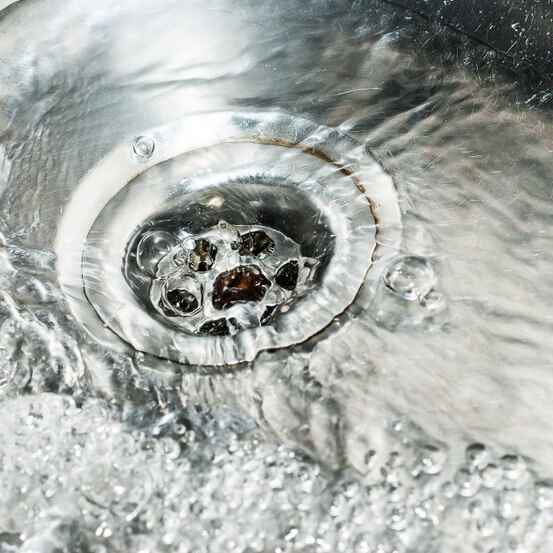Causes of a clogged drain
A clogged drain seems to only happen at an inopportune time, like while you’re cooking a holiday meal, or you have company on the way. Or maybe it’s the tub with a clogged drain after you’ve had a long, hot, soaking bath you can’t drain. Why now at these times and what causes a drain to clog?
If you’re wondering how does a clogged drain happens, the following are some of them most causes for clogged drain, most of which you can prevent:
1. Scum
Soap scum and toothpaste scum builds up inside a bathroom drain, created from soap residue, typically related to bar soaps that leave a thin film behind inside the pipes.
2. FOG
Fat, oil, grease getting poured down a garbage disposal will cause a clogged drain. Other things that are commonly poured into the garbage disposal that shouldn’t be put in the garbage disposal, or any drain, are eggshells, large food chunks and fruit peels.
3. Hair
Hair is the most common culprit cause of clogged drains.
4. Paper and Paper-Like
What may seem the most normal thing to flush is probably the worst thing you can flush. Tissues, cotton balls, baby diapers, baby wipes, and feminine products.
5. Paper Towels and Paper Napkins
These should never be flushed down the toilet! Put it in the trash and take the trash out if that grosses you. These paper products are too thick for toilet plumbing.
6. Debris and Dirt
Whether you’ve been out gardening or coming in from a soccer game, shake the dirt and grass off before you get in the shower.
7. Toilet Paper
Yes, you can flush toilet paper down the toilet, but not big wads along with human waste. Courtesy flush, clean again and flush again. Two flushes are better than a toilet with a clogged drain.
8. Foreign Objects
This is more typical of homes with small children. Toddlers like to put things in the toilet, flush it, and watch them spin around and go down. Unfortunately, they don’t always go down all the way.
What to use to clean blocked drain?
When a homeowner knows certain techniques and is armed with the certain tools, a clogged drain isn’t any big deal. Here are steps to cleaning a clogged drain in the bathroom or kitchen using a basic plunger and a plumber’s auger.:
- Fill the sink ¼ full of water.
- Start vigorously plunging up and down quickly several times. If you’re clearing a clogged drain in a double sink, plug the other side up with a rag.
- If the plunging doesn’t clear the clogged drain, remove the P-trap under the sink and let the water out into a bucket.
- Feed a plumber’s auger into the stub until you hit the clog.
- Pull 18 inches of the cable out and then lock it in place.
- Turn the handle clockwise while pushing forward to drive the cable into the pipe further.
- As the cable get hung up, turn the crank counterclockwise while pulling the cable out.
- When the cable is clear, repeat clockwise cranking and pushing into the pipe again.
- Remove the cable, put the P-trap back on and turn the hot water on.
- If still slow draining, fill the sink ¼ full of water and plunge again.
- Run hot water for 5 minutes.
Is Drano really bad for pipes?
Of course the manufacturer of Drano claims it is perfectly safe to use their product. Experienced plumbers however have a different viewpoint. Since they are the ones on the frontline, so-to-speak, their opinion may hold more value.
Experienced plumbers say that a chemical cleaner can make a clogged drain worse. The chemical may break things up, but it then turns it all into a congealed, solid mass that will actually make the clogged drain more clogged.
Another caution that experienced plumber offer when using Drano for clogged drains is what can do to the pipes. Drano sits inside pipe “working” to dissolve the clog and is continually reacting while generating heat. Using Drano or other chemicals in a clogged toilet can crack the bowl from the heat. Drano will soften PVC pipes and eventually they will break, and if your pipes are corroded and old, Drano can damage them by eating away the glue that is holding them together.

How do you unclog a drain naturally?
When the plunger method isn’t working, you can try these natural methods to open up a clogged drain. In fact, you may want to do one of the following methods every 30 days to keep your drains open.
- Baking Soda and Vinegar: Pour half a cup baking soda and half a cup vinegar down drain then put the plug in and wait 60 minutes. Now pour boiling water in the drain. Repeat this if that doesn’t work the first time to open a clogged drain.
- Baking Soda and Lemon Juice: Pour half a cup baking soda and half a cup lemon juice into the drain and plug it closed. After one hour, pour boiling water into the drain.
- Baking Soda and Salt: Mix half a cup of table salt with half a cup baking soda and pour into the clogged drain. Wait thirty minutes and add boiling.
How much does it cost to clean a clogged drain?
Remember that plumbers typically charge by the hour, not by the job. If you’ve tried everything we’ve suggested and still have a clogged drain, make that phone call. Be prepared for rates that start around $50 and can go up to $150 for the first hour with a total bill reaching upward of $180.
Can too much baking soda clog a drain?
No, because this isn’t a closed system where pressure build up. Baking soda is one of the most gentle, yet effective, ingredients you can have in your home. It is good for removing odor in almost everything you can from bad breath to smelly stains in the carpet. Call (817) 476-9963 today for your drain cleaning needs in Fort Worth, TX.
